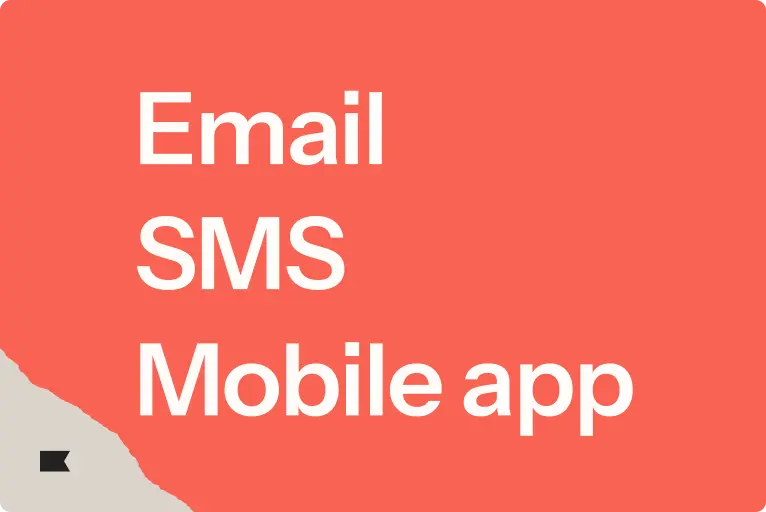9 actionable tips for staying profitable during BFCM

Staying profitable during Black Friday Cyber Monday is a balancing act.
While the holiday season is one of the best times to boost sales and acquire new customers, the key to long-term success lies in not just increasing revenue, but also maintaining healthy profits throughout this high-stakes shopping season.
Of course, this is easier said than done.
I’m the founder of Polaris Growth, where we’ve helped more than 60 ecommerce brands use Klaviyo to optimize their marketing efforts. And each year, I see opportunities for businesses to increase growth and profitability during this peak shopping season.
1. Offer profit-friendly incentives
Intense discounts can put a squeeze on your margins during BFCM. But there are ways to create value for customers—without sacrificing a good chunk of your profits.
This approach involves combining multiple products into a single package deal, at a price that’s slightly lower than buying each item separately. Customers feel they’re getting more for their money—even if the discount per item is modest. By carefully selecting which products to bundle, you protect your overall margins.
For instance, you can offer 10% off orders over $50, 15% off orders over $100, and 20% off orders over $150. This approach incentivizes customers to add more items to their cart to reach the next discount tier, boosting your overall average order value (AOV).
Instead of discounts, you can offer customers a sample-sized product, a branded accessory, or a limited-edition item. The perceived value of a free gift often outweighs its cost to you, making this a great way to attract customers without significantly impacting your margins.
2. Tailor your marketing to high-value segments
I’m a big fan of using Klaviyo’s customer segmentation because it’s a high-impact, low-effort way to protect your margins.
One of my favorite use cases around BFCM is to create segments for VIP customers based on their spending habits or purchase frequency. There are 3 primary approaches to take when deciding who your VIP customers are:
Identify customers who have spent over a certain amount in the last 365 days.
Target customers who have made a specific number of purchases in the last 365 days.
Combine spending and frequency thresholds to capture your most valuable customers.
Once you’ve identified your VIPs, you can nurture these relationships with exclusive offers, early access to BFCM sales, or personalized bundles. All of this will help you build loyalty and increase the AOV and lifetime value (LTV) of your best customers.
3. Take advantage of opportunities to up- and cross-sell
When people are already shopping in your store or on your website during BFCM, there’s an opportunity to boost your AOV via upselling and cross-selling. One way to do this is by providing on-site recommendations for related or upgraded products.
For example, if you’re a footwear brand and a customer is browsing for running shoes, you can display a section titled “Complete Your Running Gear”—featuring moisture-wicking socks, running shorts, and a water bottle. You can even position these as stocking stuffers to spark gift ideas for customers.
But even after a customer completes a purchase, there’s an opportunity to capture more revenue.
I like to encourage my clients to implement up- or cross-sell email flows to follow up after a purchase—whether that’s by sending personalized recommendations a few weeks after BFCM or offering a one-time special deal on a related product immediately after the purchase.
4. Optimize for profit on ad spend
Make every ad dollar count during BFCM by optimizing for profit on ad spend (POAS) rather than just return on ad spend (ROAS).
While ROAS measures the gross revenue generated for every dollar spent on advertising, POAS takes into account your profit margins. So even though a campaign with a 4x ROAS might seem successful, your POAS may show otherwise.
This is especially important during BFCM when many businesses offer significant discounts. POAS also factors in costs like shipping, payment processing fees, and product costs, which can fluctuate during high-volume sales periods like BFCM.
To optimize your POAS, focus on advertising high-margin products. While the definition of a high margin will depend on the industry, in general I’d encourage brands to focus on the top 20% most profitable products that they’re selling.
You can also utilize CLV in your CRM strategy. Again, I like to use Klaviyo’s segmentation to create highly targeted audiences for BFCM ads, such as a lookalike audience based on the highest CLV customers.
5. Avoid promoting high-return products
One easy way to minimize costly returns is to avoid heavy promotion of products with high return rates.
Since return rates can vary significantly depending on the industry, use benchmark data to gauge whether the rates for a certain product are considered high.
Or, if you have access to your BFCM data from last year, use that to identify which of your products had the highest return rates.
The main problem you’re trying to prevent is promoting products that, on average, have the highest return rate in your assortment.
While many factors can impact returns, you want to minimize the chances of paying top dollars to get people to your shop—only to create even more work and costs for your team because you chose to market the wrong product.
Returns will always cost businesses money, but this approach will better protect your profits and ensure a better customer experience.
6. Promote profitable payment and shipping methods
While most brands focus on the shopping experience, it’s equally important to pay attention to what comes after: payment and shipping. Here are two ways to guide customers towards options that benefit your bottom line:
Different payment methods come with varying transaction costs for your business. Find ways to nudge customers toward the lower-fee options. For instance, you can offer a small discount for using certain payment methods. To figure out how much of a discount to offer, start by comparing payment methods and measuring the difference between those options. The goal, of course, is to promote the cheaper alternative for your business. Keep in mind that returns may have additional handling costs as well.
Consider providing free shipping with minimum order values set above the AOV, which can increase average order size while keeping shipping costs manageable.
You can also look at the cost of each shipment carrier and promote the cheapest options, while adding a small fee for the more expensive ones.
7. Prevent buyer’s remorse
Reduce returns and build customer satisfaction by implementing post-purchase email flows that reinforce the value of people’s BFCM purchases. A few ideas:
- Send a celebratory “your order is on the way” email after the package ships to build excitement.
- Share usage or educational tips for the product someone purchased to help them get the most value out of it.
- Showcase user-generated content featuring the product a customer purchased for inspiration.
When returns are necessary, prioritize exchanges or store credit over refunds to retain the customer’s business.
8. Give back to a good cause
Consider donating a portion of your BFCM profits to a charity that aligns with your brand values.
If you sell outdoor gear, for instance, you might partner with an environmental conservation organization.
You can then create a special BFCM collection where a higher percentage of sales goes to charity, or offer customers the option to round up their purchase to the nearest dollar for donation.
This approach not only contributes to a good cause, but can also account for premium pricing and attract customers who want their purchases to make a positive impact. Just ask London Sock Co.—when the brand donated two pairs of socks to a homeless charity for every purchase during BFCM, the strategy contributed to a 180% increase in AOV during the sale period.
9. Re-engage customers post-BFCM
Don’t let your BFCM customers disappear after the holidays. Here are a few ideas to re-engage customers after the holiday rush dies down:
With Klaviyo, you can tailor your messages based on purchase history and LTV. For instance, create a segment of first-time BFCM buyers and send them a welcome series that introduces your brand story, showcases your best-selling products, and offers a small incentive for their next purchase.
After BFCM, send them personalized product recommendations based on their recent buys, or create an exclusive “loyal customer” offer for the new year.
This is a great way to gather feedback and improve future campaigns, while also keeping your brand top of mind for customers. By focusing on these post-BFCM engagement strategies, you can turn one-time holiday shoppers into year-round revenue drivers, maximizing the long-term value of your BFCM efforts.
Use these strategies to protect your hard-earned BFCM profits
I’ve seen firsthand how these strategies can help brands keep more money in their pockets during and after the holiday season. Start planning to implement these strategies right now to help make your BFCM as profitable as possible.
Related content
- You don’t want to miss these 5 benefits of effective Black Friday marketing
- 10 expert-tested best practices for Black Friday marketing
- 10 digital BFCM tactics we already know customers love
- 10 key steps in building a solid Black Friday Cyber Monday strategy

Related content

Boost revenue and loyalty with 8 creative Singles’ Day and Double 11 marketing ideas. Learn how Klaviyo helps you personalize, automate, and scale every campaign.

Choosing the right marketing channels for your business is high stakes when you have a limited budget. Learn how to maximize ROI with the right strategy.

Build BFCM interest this Halloween with 6 proven email marketing and SMS strategies to gather customer data and get ahead of Q4 revenue goals.